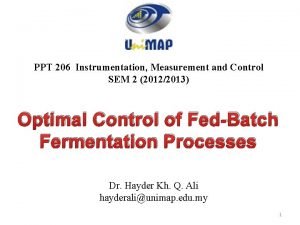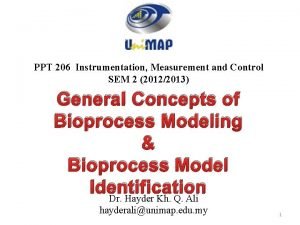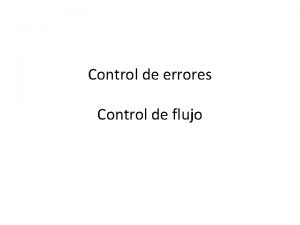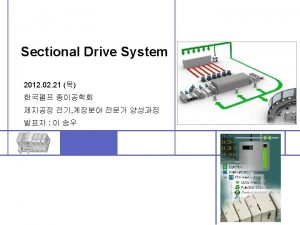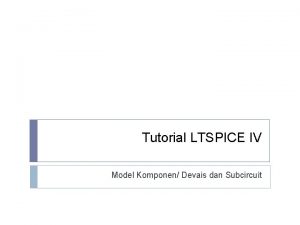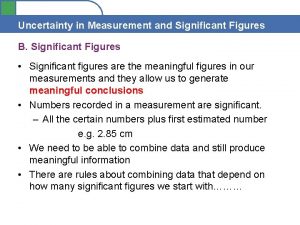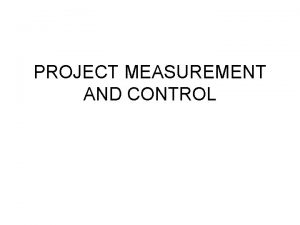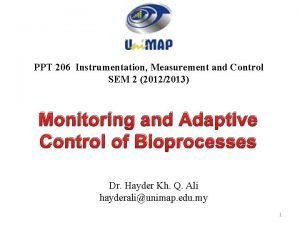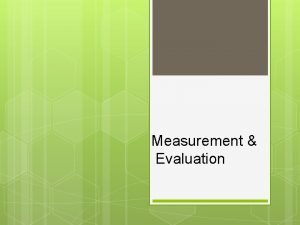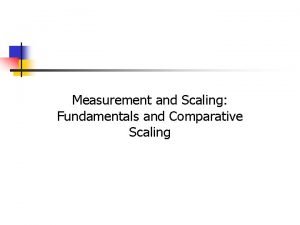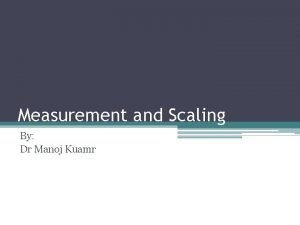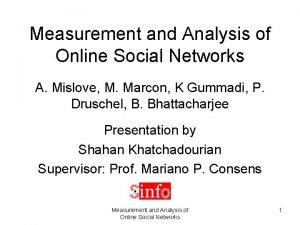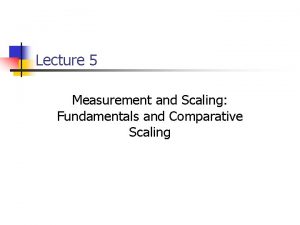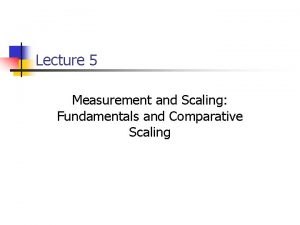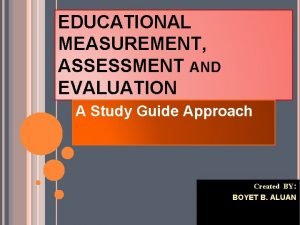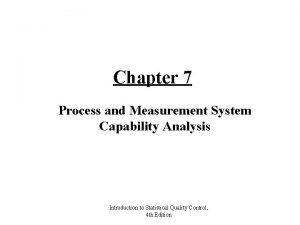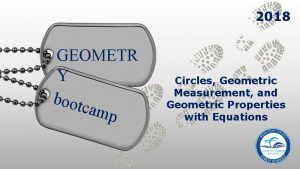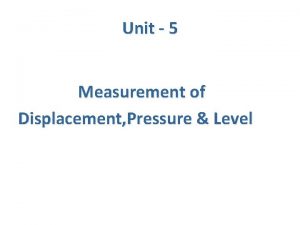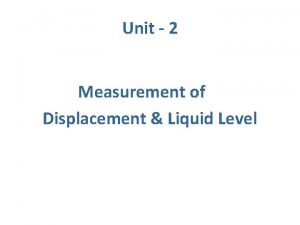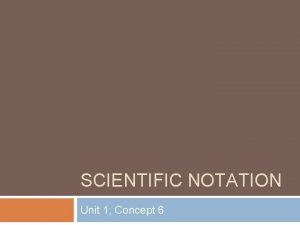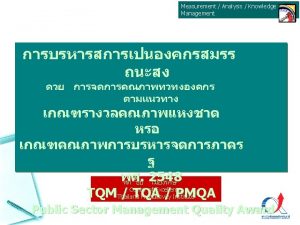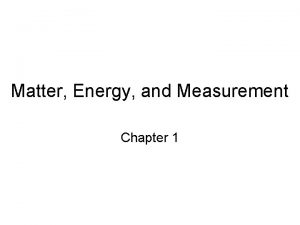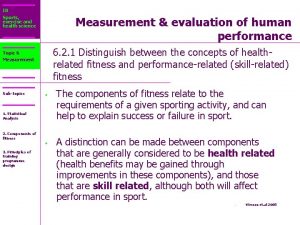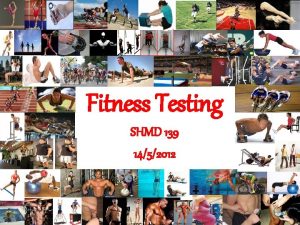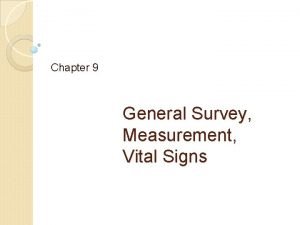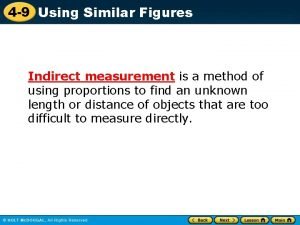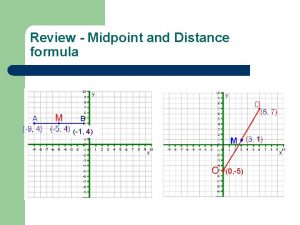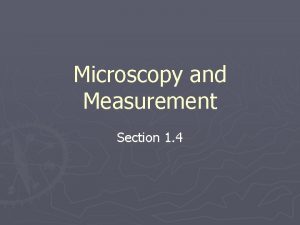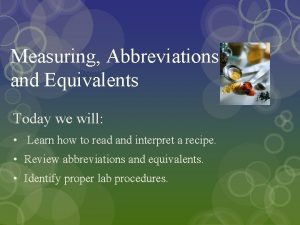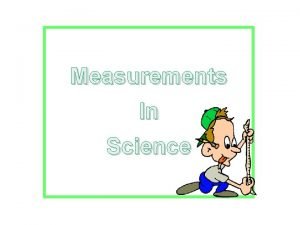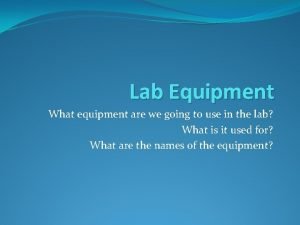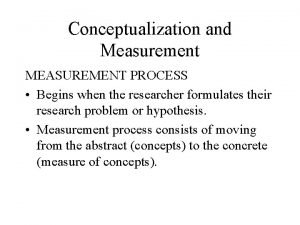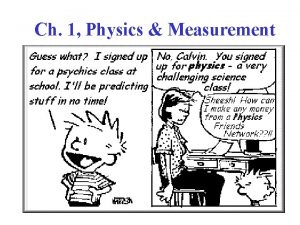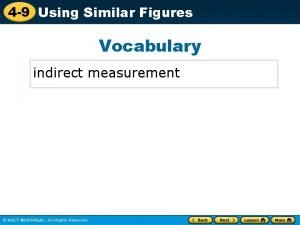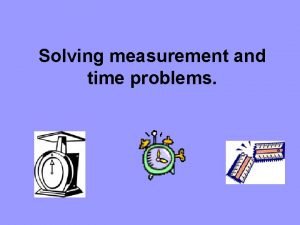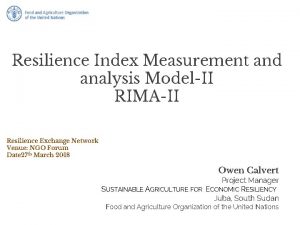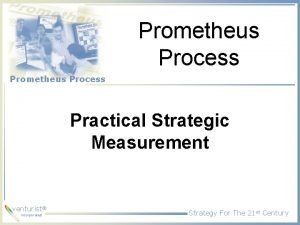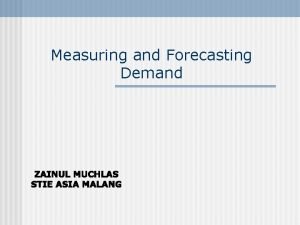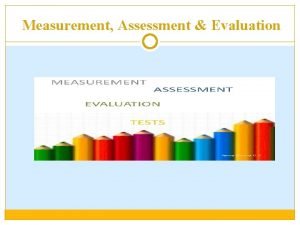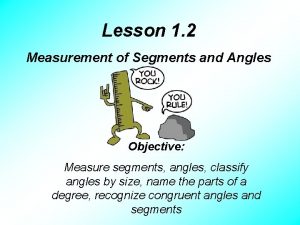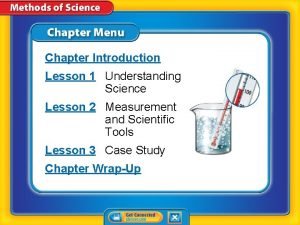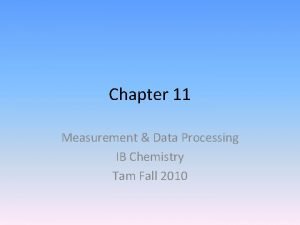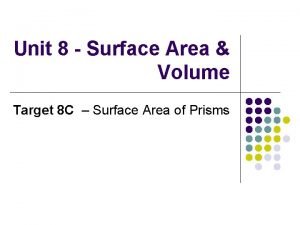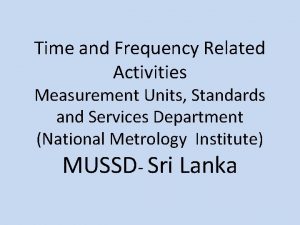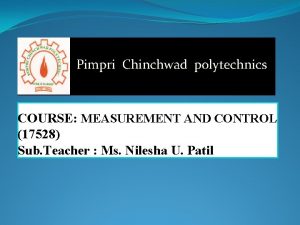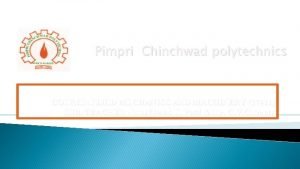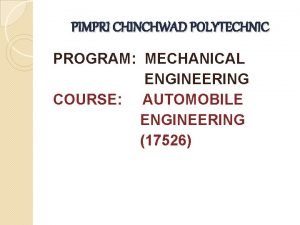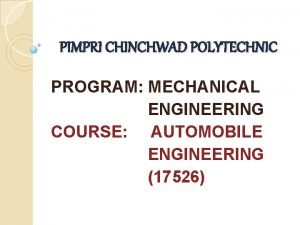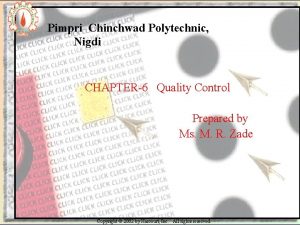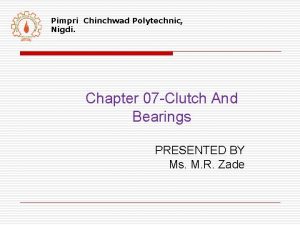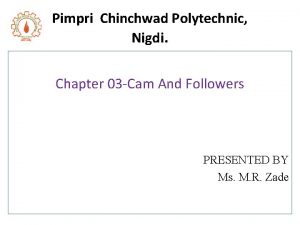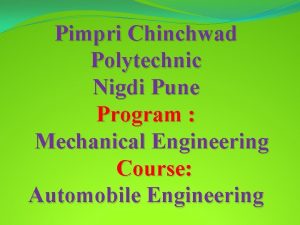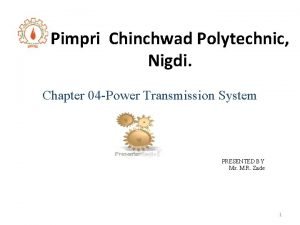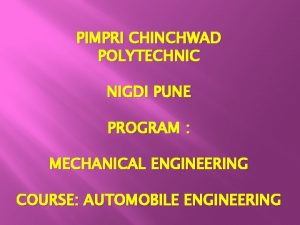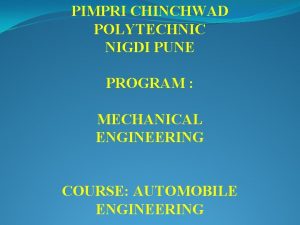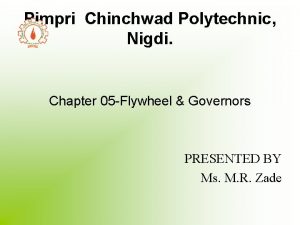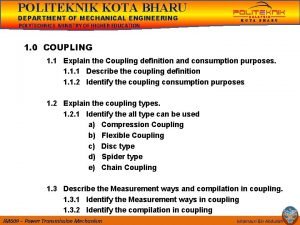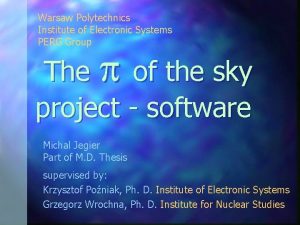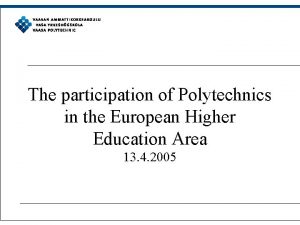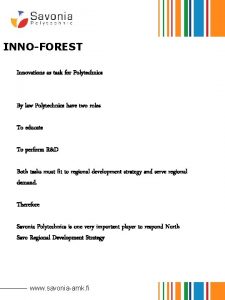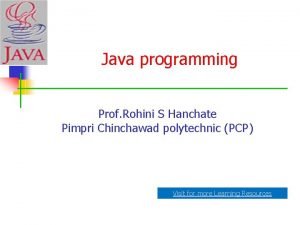Pimpri Chinchwad polytechnics COURSE MEASUREMENT AND CONTROL 17528





















































































- Slides: 85

Pimpri Chinchwad polytechnics COURSE: MEASUREMENT AND CONTROL (17528) Subject Teacher: Ms. Nilesha U. Patil

Chapter No. -03 Temperature Measurement FHH Co-Know the different temperature measuring instrument with their construction and working

Temperature measurement �Temperature is measure of thermal energy in a body. �It is the hotness or coldness of a medium �Hotness or coldness is indication of heat and is compared by giving some reference of unit

Temperature scale A) Fahrenheit scale: Abbreviated as (°F) 2) First to gain acceptance 3) Proposed in the early 1700 s by Fahrenheit (Dutch) 4) Freezing point- 32 °C, Boiling point- 212 °C 1)

…. B) Centigrade or Celsius scale: Abbreviated as (°C) 2) Proposed in the mid 1700 s by Celsius (Sweden) 3) Freezing point- 0 °C, Boiling point- 100 °C 1)

…. C) Rankine scale: Abbreviated as (°R) 2) Proposed in the mid 1800 s by Rankine 3) Freezing point- 491. 6 °C, Boiling point- 671 °C 4) Based on Fahrenheit scale 1)

…. C) Kelvin scale: Abbreviated as (°K) 2) Proposed in the late 1800 s by Lord Kelvin 3) Freezing point- 273. 15 °C, Boiling point- 373. 15 °C 4) Based on Celsius scale 1)

Classification of Temperature Measuring Devices Based on nature of change produced: i) Glass thermometer: - Work on the principle of expansion of liquid like mercury, alcohol, pentane etc. ii) Pressure guage thermometer: - produce pressure O/P on a/c of vapour or liquid. a) liquid filled b) vapour filled c) gas filled iii) Bimetallic thermometer or differential thermometer: - O/P is on a/c of differential expansion of dissimilar metals produced by temp.

…. iv) Electrical resistance thermometer: - temperature is measured by resistance o electrical wire v) Thermocouples: - Temperature is indicated by production of emf vi) Optical pyrometer: - Temperature is determined by luminosity of hot body that of a calibrated source vii) Radiation Pyrometer: - Measures temp by absorbing radiation viii) Fusion pyrometer : - Temp. is determined by which of a series of material with graduated fusion material melt or soften due to temp.

…. ix) Calorimetric pyrometer: - Temp. is determined by measuring quantity of heat removed when temp. of body brought from unknown to known level. x) Electrical and non electrical type: - Those which are electrical or electronic in nature and those which are not. xi) Temperature range: - Range for which different types of temp measuring devices are used along with their accuracies. xii) Thermister: - It measures temp by relating change in resistance with change in temp

Non electrical methods Expansion thermometer 1) a) Expansion of solid 1) Bimetallic thermometer b) Expansion of liquid 1) 2) Liquid in gas thermometer Liquid in metal thermometer c) Expansion of gas Filled system thermometer 2) 1) 2) 3) 4) 3) Gas filled thermometer Liquid filled thermometer Mercury filled thermometer Vapour filled thermometer Pyrometer

LIQUID IN GLASS THERMOMETER Construction �The unit consists of glass envelope, a responsive liquid an indicating scale �The envelope comprises a thick walled glass tube with capillary bore and cylindrical bulb filled with liquid �Size of capillary depends on the sensing bulb, responsive liquid and desired temp range.

Diagram

. . Working �Changes in temp will cause the fluid to expand rise up the stem �Since the area of stem is much less than bulb, relatively small changes of fluid volume will result in significant fluid will rise in the stem �Length of the movement of free surface of fluid column serves, by prior calibration to indicate temp of bulb

Advantages �Simple to use �Low cost �Easily portable �Ease of checking for physical damage �No need of auxiliary power �No need of additional indicating instruments �Good accuracy

Disadvantages �Fragile construction �Can not be adopted for remote reading �Time lag �Limited range (about 600 °C)

Bimetallic Thermometer

Bimetallic thermometer Construction �A metallic thermometer consists of two pieces of different metals having different coefficient expansion firmly bonded together by welding �Bimetallic elements can be arranged in the flat, spiral, single helix configuration �One end of helix is anchored permanently to the casing and the other end is secured to the pointer

Bimetallic Thermometer

Working �In response to temperature change, the bimetal expands and the helical bimetal rotates at its free end �When free end of bimetallic strip is heated , it bends in the direction of material having low thermal coefficient of expansion �This movement is connected to pointer which moves over calibrated scale �The curvature of bimetal spiral strip varies with temp and causes a pointer to deflect

Advantages �Low cost �Simple in design �Compact and robust in construction �No maintenance is required �Overloading can be tolerated

Disadvantages �Low speed of response �Creep at high temperature

Pressure Thermometer �A pressure thermometer operates by expansion of gas or liquid. �A pressure thermometer measures temperature indirectly by measuring pressure. �The gauge is a pressure gauge, but is typically calibrated in units of temperature instead.

Pressure Thermometer Construction �A thermal system partially filled with a volatile liquid and operating on vapour pressure that depends on temperature at the free surface of liquid. �The bulb is partially filled with a volatile liquid and rest of system contains vapour

Types of Pressure Thermometer a. Liquid pressure thermometers. b. Vapour pressure thermometers. Pressure Gauge Thermometer. 25

LIQUID PRESSURE THERMOMETER �It is temperature measuring device whose operation is based on thermal expansion of a liquid. �These are also called as fluid-expansion thermometers. �Liquid filled thermometers have range from -30° C to 250° C. �The measurement accuracy depends on the depth of immersion of thermometer in the medium to be measured.

…. Working �An increase in the temp. at the bulb causes vapourization of volatile liquid �The resulting increase in vapour pressure is measured by a pressure spring and instrument is calibrated in terms of temp. �For cross ambient temp. measurement , dual fill system is used. In this two different liquids vapourizing and non vapourizing are used

LIQUID PRESSURE THERMOMETER Pressure Gauge Thermometer. 28

Construction and Working : �A bulb containing a liquid is immersed in the environment. �The bulb is connected by means of capillary tube to a pressure measuring device, like a bourdon tube pressure gauge. �An increase in temperature causes the liquid to expand, which causes increase in pressure on gauge. �The liquid filled tube are also temperature sensitive so it may cause error. �Error can be reduced by increasing bulb size, but it may increase the response time of system. �The system with bulb, tube, and a pressure gauge can be calibrated directly. Pressure Gauge Thermometer. 29

VAPOUR PRESSURE THERMOMETER �These are similar to liquid filled thermometers, but contain only partially filled bulbs. �Vapour pressure thermometer have range of 20°C to 350°C. �The saturated vapour pressure of volatile liquid is used as a measure of temperature. Pressure Gauge Thermometer. 30

Pressure Gauge Thermometer. 31

Construction and Working: �They use the principle that the vapour pressure of a liquid depends on the temperature, and most fluids partially filled in an enclosed chamber will create a definite vapour pressure. �When the fluid reach the boiling point, the vapour pressure will be equal to the total pressure above the liquid surface and can be used as the measure of temperature. �Further when the partially filled bulb senses the temperature vapour will be formed in the remaining space of the bulb and is passed through a capillary tube to the indicator with a bourdon tube. Pressure Gauge Thermometer. 32

Advantages �Simple and inexpensive �Rugged construction �Ease of installation and use �Fairly good response, accuracy and sensitive �Self operated system �Remote indication (upto 100 m)

Disadvantages �Large time lag �Compensation required for ambient temp. �Upper limit for measurement is low as compared to electrical system

Range: �Liquid Range (°C) Argon down to -253 °C Ethyl 90 -170 Methyl chloride 0 -50 Water 120 -220

Applications : �Dairy and Food Industries. �Suitable for Heating and Ventilation application. Pressure Gauge Thermometer. 36

Electrical Methods: resistance thermometer �Can be called as Resistance temperature detector �Resistance-Temperature relationship R= Ro(1+α θ) here, α-temp coeff. Of resistance θ-Temp. relative to 0 °C If change in temp. from θ 1 & θ 2 is considered R 1= Ro(1+α θ 1) R 2= Ro(1+α θ 2) Rearrangement gives: θ 2= θ 1+(R 2 -R 1/ αR 0) R 2 -R 1/ θ 2 -θ 1= αR 0 �Thus change in resistance is directly proportional to change in temp.

RTD �RTD can also be called a resistance thermometer as the temperature measurement will be a measure of the output resistance. �The main principle of operation of an RTD is that when the temperature of an object increases or decreases, the resistance also increases or decreases proportionally. �ie. positive temperature coefficient

Construction : � It comprises a bulb or resistance element , suitable electrical leads and an indicating-recording instrument � Bulb is in the form of coil of very fine platinum, nickel wound onto an insulating ceramic former � Ceramic former is protected by metal sheath � Industrial resistance thermometer, often referred to as RTD are usually made with elements of platinum, nickel and copper

…. Working: �Change in temp will cause change in resistance of the coil �Leads are taken out of thermometer for the measurement of changes in resistance Range: �Upto 1200 °C

Advantages: �Simplicity in operation �Easy installation �Replacement of sensitive bulb �Average temp can be measured �Very high accuracy �Excellent stability and reproducibility �Ability to be matched to close tolerances for temperature difference measurements. �Ability to measure narrow spans �Suitability for remote measurement

Disadvantages: �More time lag due to protective sheath �Possibility of current leakage �Susceptibility to mechanical damage �Need for lead wire resistance compensation �Sometimes expensive �Susceptibility to self-heating error �Susceptibility to signal noise �Unsuitability for bare use in electrically conducting substance �Generally not repairable �Need for power supply

Thermistor �Principle: �Thermistors are semiconductor having negative temp coeff. �As temp increases, resistance goes down and as the temp decreases , resistance goes up �Temp-resistance relationship is given by�Rt= Ro. B(1/T-t/To)

…. Construction �Thermistors are composed of mixture of metallic oxides such as manganese, nickel, cobalt, copper, iron and uranium �These metallic oxides are mixed in appropriate properties and are pressed into desired shape with appropriate binders and finally sintered �Thermistors may be shaped in the forms of beads, disks, washers, rods �Glass and metal probes are used for temp measurement

THERMISTOR

…. Working: �Temp change will cause change in resistance �This change in resistance is measured by using circuitary similar to that of metal conductor Range �Approximately : -100 °C to 300 °C

…. Advantages : �High sensitivity �Availability in very small size �Fast thermal response �Low cost

Thermoelectric measurement �Thermocouple �Radiation pyrometer �Optical pyrometer

Definition-Pyro is a greak word which means fire. -Pyrometer is a non contact type instrument Which is used to measure temperature.

WORKING PRINCIPLE Pyrometer Optical system & detector Optical system- Thermal radiation Output thermal radiation Temperature is sensed detector

Radiation Pyrometer Principle �Radiation pyrometer works on the Stefan-Boltzman law �Stefan-Boltzman law applied to non black body is stated below: � E=Єбo. T E-emmisive power. Є-emmisivity �For two bodies at temp T 1 & T 2(T 2>T 1), the energy transfer relation is given by: E=Єбo(T 2 -T 1) �It is basis for temp measurement

RADIATION PYROMETER

…. Construction �The pyrometer is designed to collect the radiations from radiating object and focus it by means of mirrors or lens onto detector (thermocouple) �The emf generated by thermocouple circuit is measured by suitable milivoltmeter or potentiometer �Suitable calibration of this milivoltmeter or potentiometer becomes a measure of temp of radiating object

Working of radiation pyrometer-

…. Working: �The eye piece and concave mirror are adjusted to focus the radiation from furnace onto the target i. e. thermocouple hot junction �This will generate emf , which is used to measure the temp of radiation Range: 700 -2000 ºC

…. Advantages: �High speed of response �No direct contact with object �Can be used to measure the temp of moving object �Can be used for sensing the temp at long distance

…. Disadvantage �The effect of dust and dirt on mirror is cause the instrument to read too low �Cooling is required

Optical pyrometer Principle �When the surface is heated, it emits radiations of different wavelength. By measuring this wavelength we can measure the temp. �Optical pyrometer compare the energy emitted by body at a given wavelength with that of black body calibrated lamp

Working of optical pyrometer-

…. Construction �Radiation from the target surface are focused by an objective lens upon the plane filament of an electric light bulb �Red filter is placed between the eyepiece and filament �Eyepiece is provided to observe the filament �Brightness of lamp filament can be varied by adjusting current through standard lamp

…. Working: �When the filament is different in terms of brightness from target surface, then it is radiating at same intensity as the target surface �When filament is colder than the target surface it appears as a wire �When filament is hotter than the object it appears brighter than target surface �The current through the filament is then reduced provide correct merging of filament & object �Thus current through filament will be basis for temp measurement Range: 700 -3000 ºC

…. Advantages: �No direct contact required �Excellent accuracy �Measurement is independent of distance between target and instrument �Has been accepted as standard means for determining temp on international temp scale

…. Disadvantages: �Require operator, hence not suitable for automatic control applications �Lower measuring temp is limited to 700 ºC

Applications- 1. )They can be used in the environment which Contaminate or limit the life of thermocouple 2. )They are used for targets not easily accessib Such as furnace indicators. 3. )they are used for measurement of average Temperature of large surface areas. 4. )they are used for the measurement of Temperature above practical operating Range of thermometer.

Difference between radiation and optical pyrometer Property Radiation pyrometer Optical pyrometer Temperature range More than 550 degree centigrade More than 750 degree centigrade accuracy 10 degree centigrade stability good Very good sensitivity fair good caliberation By comparison with standard optical pyrometer Against standard tungsten strip lamp.

Thermocouple �The most common electrical method of temperature measurement uses thermo -electric sensors also known as Thermocouple (TC). �Thermocouple is active transducer which generates e. m. f by its own

Thermocouple

What are thermocouples? �Thermocouples operate under the principle that a circuit made by connecting two dissimilar metals produces a measurable voltage (emf-electromotive force) when a temperature gradient is imposed between one end and the other.

Construction of Thermocouple �The thermocouple conductors must be insulated from the hot junction to the indicating instrument. �The two wires also should not touch each other except hot junction. �Therefore suitable insulating materials should be used according to temperature ranges.

Seeback effect �The Seebeck effect is a phenomenon in which a temperature difference between two dissimilar electrical conductors or semiconductors produces a voltage difference between the two substances. �An electric current flows from hot junction to cold junction, this produces voltage proportional to temperature at the junction.

Seeback effect

Peltiers effect �When a loop is formed of two dissimilar metals and if externally current is forced to flow through the circuit, one of the junction is heated while the other is cooled. �The Peltier effect is a temperature difference created by applying a voltage between two electrodes connected to a sample of semiconductor material. This phenomenon can be useful when it is necessary to transfer heat from one medium to another on a small scale. �Amount of heat absorbed when unit current passes from a unit time is called peltier effect

Peltier effect

Thomson effect �When current flows along a wire whose temperature varies from point to point , heat is liberated at any point P when current at P is in same direction as heat flow. Heat is absorbed at P if current is in opposite direction to heat flow.

Thermocouple �Principle �Seeback effect : when two conductor of dissimilar metals M 1 & M 2 are joined together to form a loop and two unequal temp T 1 & T 2 are imposed at two interface connection. An electric current flows through the loop �Laws of thermocouple 1. Law of homogeneous circuit: �An electric current cannot be sustained in a circuit of a homogenous metal by application of heat alone

…. 2. Law of succesive or intermediate temp: The emf generated in a thermocouple with junctions at temp T 1& T 3 is equal to sum of emf generated by similar thermocouples, one acting between temp T 1 & T 2 and the other acting between T 2 & T 3 where T 2 lies between T 1 & T 3. 3. Law of intermediate metals: if thermal emf’s of any two metals with respect to reference metal are known , the emf of the combination of two metals is the algebric sum of their emf’s against the reference metal

…. Construction: �Two dissimilar conductors eletrically insulated except at the hot junction , where conductors may be either be welded together. �A refractory and a metal sheath is provided to protect thermocouple �Compensating leads are taken for measuring the temp

…. Working: �Temp temp at hot junction will emf in circuit �The emf is used to measure the chang in temp Range: �Thermocouple Range (ºC) �Copper-constanton -200 to 400 �Iron-constanton -200 to 800 �Chromel-alumel -200 to 1200

…. Advantages: �Sensing element can be installed easily �Have a better speed of response �Higher range of temp Disadvantage: �Poor sensitivity �Change in ambient temp affect accuracy �Measure temp indirectly

Disadvantages �Cold junction, cable and lead compensation is essential for measurements. �Needs signal amplifications. �They exhibit non-linearity in emf vs. temperature characteristics. �Stray voltage pickup is possible.

Applications. �To monitor temperature of liquids and gases in storage and flowing pipes and dusts. �In industrial furnaces. �For temperature measurements in cryogenic range.

Difference between RTD and THERMIS RTD THERMISTER 1. Material used is platinum , copper , nickel as resistance wire. 2. Large in size. 3. Having more cost. 4. Less sensitive. 5. High temperature range. 1. Mixture of metallic oxides such as nickel , cobalt , manganese used. 2. Small in size. 3. These are cheap. 4. Higher sensitivity. 5. Small temperature range.

ference between RTD and THERMOCOUP RTD THERMOCOUPLE. 1. It measure low range of 1. It measure high range of temperature -200 to 1000°C. temperature. 2. RTD is more sensitivity. 2. It is less sensitivity. 3. Ambient condition do not 3. Ambient condition affect the temperature measurement. 4. It has slow response. 4. It has better response.

Difference between RESISTANCE THERMOMETER and THERMISTER Resistance thermometer Thermister 1. Made of metals which are good conductor of electricity e. g copper , platinum, nickel. 2. Works in temperature range of -200 to 1000°C. 3. They have better reproducibility and low hysteresis. 4. Relatively bigger in size. 1. Made of metallic oxide such as cobalt, manganese , nickel , iron. 2. Works in temperature range of -100 to 300°C. 3. They have less reproducibility and more hysteresis. 4. Small in size.

THANK YOU. .
 Lokmanya hospitals private limited
Lokmanya hospitals private limited World federation of colleges and polytechnics
World federation of colleges and polytechnics Course title and course number
Course title and course number Instrumentation and control systems ppt
Instrumentation and control systems ppt Instrumentation and control systems ppt
Instrumentation and control systems ppt One brick t junction in english bond
One brick t junction in english bond Course interne moyenne externe
Course interne moyenne externe Process control and product control
Process control and product control Difference between positive and negative control
Difference between positive and negative control Flow and error control
Flow and error control Progress and performance measurement and evaluation
Progress and performance measurement and evaluation Progress and performance measurement and evaluation
Progress and performance measurement and evaluation Translational research institute on pain in later life
Translational research institute on pain in later life Reynolds transport theorem
Reynolds transport theorem Stock control e flow control
Stock control e flow control Control volume vs control surface
Control volume vs control surface Positive control vs negative control
Positive control vs negative control Hdlc adalah
Hdlc adalah Control de flujo y control de errores
Control de flujo y control de errores Negative control vs positive control examples
Negative control vs positive control examples Sectional drive
Sectional drive Control c control v
Control c control v Chapter 7 work design and measurement
Chapter 7 work design and measurement Significant figures cartoon
Significant figures cartoon Peer review process cmmi
Peer review process cmmi Process instrumentation ppt
Process instrumentation ppt If you don't measure it you can't manage it
If you don't measure it you can't manage it Concept map of measurement assessment and evaluation
Concept map of measurement assessment and evaluation Nominal ordinal scale
Nominal ordinal scale Manoj kuamr
Manoj kuamr Measurement and analysis of online social networks
Measurement and analysis of online social networks Measurement and scaling
Measurement and scaling Measurement and scaling
Measurement and scaling Concept map of measurement assessment and evaluation
Concept map of measurement assessment and evaluation Approaches to measuring performance
Approaches to measuring performance Tolerance ratio
Tolerance ratio Examples of ordinal scale
Examples of ordinal scale Defining performance and choosing a measurement approach
Defining performance and choosing a measurement approach Forecasting and demand measurement
Forecasting and demand measurement Geometry bootcamp answers
Geometry bootcamp answers Lvdt conclusion
Lvdt conclusion Displacement
Displacement Sot and reach
Sot and reach Scientific notation worksheet doc
Scientific notation worksheet doc Measurement and analysis of online social networks
Measurement and analysis of online social networks Dr kano's house of tqm
Dr kano's house of tqm Matter energy and measurement
Matter energy and measurement Measurement and evaluation in human performance 5e download
Measurement and evaluation in human performance 5e download Body structure general survey
Body structure general survey T test fitness
T test fitness Normal pediatric vitals by age
Normal pediatric vitals by age Describe the new accountability in terms of romi
Describe the new accountability in terms of romi Unit of measurement for power
Unit of measurement for power Sdm desain pekerjaan dan pengukuran kinerja
Sdm desain pekerjaan dan pengukuran kinerja Indirect measurement using similar triangles
Indirect measurement using similar triangles Vertical jump
Vertical jump Software metrics example
Software metrics example Distance midpoint and angle measurement
Distance midpoint and angle measurement Ninety types of demand measurement
Ninety types of demand measurement Microscopy and measurement section 1-4 review
Microscopy and measurement section 1-4 review What is tablespoon abbreviation
What is tablespoon abbreviation A measurement includes both a number and a unit.
A measurement includes both a number and a unit. Cmmi measurement and analysis
Cmmi measurement and analysis What platform holds heating unit pole holds clamps
What platform holds heating unit pole holds clamps The measurement process begins with
The measurement process begins with Lesson 1 understanding science answer key
Lesson 1 understanding science answer key Work design and measurement
Work design and measurement Forecasting and demand measurement in marketing
Forecasting and demand measurement in marketing Conceptualization, operationalization, and measurement
Conceptualization, operationalization, and measurement Physics and measurement chapter 1
Physics and measurement chapter 1 Similar figures and indirect measurement
Similar figures and indirect measurement Time measurement and problem solving
Time measurement and problem solving Segment and angle measurement
Segment and angle measurement Resilience index measurement and analysis
Resilience index measurement and analysis Strategic measurement and evaluation
Strategic measurement and evaluation Demand measurement in marketing
Demand measurement in marketing Concept of measurement assessment and evaluation
Concept of measurement assessment and evaluation Measurement maths literacy grade 12
Measurement maths literacy grade 12 Bar scale maths lit
Bar scale maths lit Congruent line segment
Congruent line segment Lesson 1 understanding science answer key
Lesson 1 understanding science answer key Measurement and scientific tools lesson 2
Measurement and scientific tools lesson 2 Measuring market demand
Measuring market demand Ib chemistry measurement and data processing worksheets
Ib chemistry measurement and data processing worksheets Area/volume
Area/volume Mussd
Mussd



